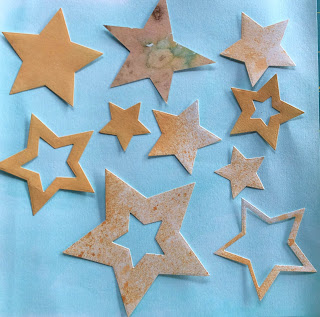- Size should be 8" square
- Theme: Growth and disintegration
- Growth - deeper/brighter colours or larger shapes
- Disintegration/decay - fading colours, worn shapes, smaller shapes, colours merging into the background - mould or lichen on a surface; worn tiles; flaking paint; rotting wood
- I would like the piece to be something that I can live with afterwards!
- The Islamic tiles which have featured in my thoughts and samples throughout this module - the repeating patterns lend themselves to this brief
- Fabrics: silk and muslin are both easily frayed and easily dyed to show the fading colours
Sample 1 in the picture above has been perforated with a hole punch
Sample 2 was crumpled and twisted until the paper had gone soft, then rubbed until holes began to appear
Sample 3 - the edges were torn
Sample 4 was soaked in water then crumpled and rubbed
Sample 5 was slashed with a scalpel then crumpled and rubbed
Sample 6 was burned with a joss stick (lavender scented so this page smells very pleasant :-))
Sample 7 was pierced with a fine knitting needle
Sample 8 was machine stitched then wet and rubbed until holes appeared
In my opinion the burned and machine stitched samples (Nos 6 and 8) are the most successful.
B. Paper experiments
These four samples show an increasingly disintegrated shape where a little more paper has been torn away each time. This works well though Sample 4 looks more like a flower to me than a star.
C. Paper shapes
Samples 1 to 4 show a negative star shape with fragments of the star which has been removed being replaced. Sample 3 is, to my mind, the most effective. And Sample 5 is the star cut from Sample 4 with its holes punched in it.
D. Fabric shapes - muslin squares were cut in various different ways and frayed to varying degrees
E. Stitched shapes
Samples a, b and c in the above image use increasing numbers of rows of running stitch to make the star appear to be disintegrating.
Sample d - needle-weaving was used to break the shape of the star up. I feel that this is more effective than the running stitch as some areas are more solidly covered.
Samples e, f and g - I took photographs of the process of stitching french knots, increasing the density on two of the star points only. Sample g looks as though it is encrusted with lichen I think.
Sample h uses cutwork - a series of small holes edged with buttonhole stitch - this works really well.
Sample i has needlelace worked on some of my painted papers. This, also works.
Sample j consists of a star cut from coloured paper with a piece of machine embroidered tissue paper fixed behind. The machine has pulled holes in the tissue and this also works really well.
All in all - some really useful techniques here and lots of ideas buzzing around in my head with regard to how to show my stars disintegrating.
F. Design ideas
I have a Sizzix machine and a nesting set of five pointed star cutters so cut out a large number of stars in different sizes and thicknesses, together with a piece of lightly painted paper cut to the finished size of 8" square, then played around with various arrangements.
I feel that the less solid and the smaller stars do look as though they're either fading into the distance or disintegrating.
I then chose a couple of the arrangements and distorted them in an app on my ipad - this has made the edges blur and look as though the stars are being worn away though I'm not entirely sure at the moment how I would replicate this in stitch.
And finally a more formal design taken from my Islamic tiles where the negative spaces between the eight pointed stars forms a cross shape.
Which to choose?? - Ideas on a postcard please!!



















No comments:
Post a Comment